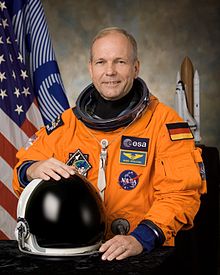Hans Schlegel
German - (ESA)
Retired
Date of Birth: Aug. 3, 1951
Age: 74
Hans Wilhelm Schlegel (Überlingen, 3 August 1951) is a German physicist, an ESA astronaut, and a veteran of two NASA Space Shuttle missions. From 1995 to 1997, he trained as the backup crew member for the German-Russian Mir'97 mission, and afterwards received additional training in Russia to become qualified as a second board engineer for the Mir space station. In 1998, he became a member of the European Astronaut Corps. Schlegel was a Mission Specialist on the STS-122 Space Shuttle mission. The mission was charged with the responsibility of putting the Columbus laboratory in orbit, in addition to its connection to the International Space Station.
Space Shuttle Columbia / OV-102 | STS-55
National Aeronautics and Space Administration | United States of AmericaKennedy Space Center, FL, USA
April 26, 1993, 2:50 p.m.
Status: Success
Mission:
STS-55 (Space Transportation System 55), or D-2 was the 55th overall flight of the US Space Shuttle and the 14th flight of Shuttle Columbia. This flight was a multinational Spacelab flight involving 88 experiments from eleven different nations. The experiments ranged from biology sciences to simple earth observations.
Low Earth OrbitSpace Shuttle Atlantis / OV-104 | STS-122
National Aeronautics and Space Administration | United States of AmericaKennedy Space Center, FL, USA
Feb. 7, 2008, 7:45 p.m.
Status: Success
Mission:
STS-122 was a NASA Space Shuttle mission to the International Space Station (ISS), flown by the Space Shuttle Atlantis. STS-122 marked the 24th shuttle mission to the ISS, and the 121st space shuttle flight overall. The mission was also referred to as ISS-1E by the ISS program. The primary objective of STS-122 was to deliver the European Columbus science laboratory, built by the European Space Agency (ESA), to the station. It also returned Expedition 16 Flight Engineer Daniel M. Tani to Earth. Tani was replaced on Expedition 16 by Léopold Eyharts, a French Flight Engineer representing ESA. After Atlantis' landing, the orbiter was prepared for STS-125, the final servicing mission for the Hubble Space Telescope.
Low Earth OrbitThe European Space Agency is an intergovernmental organisation of 22 member states. Established in 1975 and headquartered in Paris, France, ESA has a worldwide staff of about 2,000 employees. ESA's space flight programme includes human spaceflight (mainly through participation in the International Space Station program); the launch and operation of unmanned exploration missions to other planets and the Moon; Earth observation, science and telecommunication; designing launch vehicles; and maintaining a major spaceport, the Guiana Space Centre at Kourou, French Guiana.
Long March 3B/E
Fengyun-4C
Launch Complex 2 (LC-2) - Xichang Satellite Launch Center, People's Republic of ChinaChina's geostationary meteorological satellite program FY-4 (Feng Yun 4) is the second generation of chinese geostationary meteorological satellites.
Long March 8A
SatNet LEO Group 17
Commercial LC-1 - Wenchang Space Launch Site, People's Republic of ChinaA batch of 9 Low Earth Orbit communication satellites for the Chinese state owned SatNet constellation operated by the China Satellite Network Group.…
Soyuz 2.1a
Obzor-R No.1
43/4 (43R) - Plesetsk Cosmodrome, Russian FederationNote: Assignment of payloads to this launch is uncertain. The Russian Obzor-R satellite is a planned X-band radar earth observation satellite desi…
LVM-3 (GSLV Mk III)
BlueBird Block 2 #1
Satish Dhawan Space Centre Second Launch Pad - Satish Dhawan Space Centre, IndiaAST SpaceMobile’s Block 2 BlueBird satellites are designed to deliver up to 10 times the bandwidth capacity of the BlueBird Block 1 satellites, requi…
Long March 12A
Demo Flight
Long March 12A Pad - Jiuquan Satellite Launch Center, People's Republic of ChinaFirst test launch of CASC/SAST’s Long March 12A rocket, with a dummy payload. The rocket’s 1st stage attempted to land on a landing pad about 300 km …



